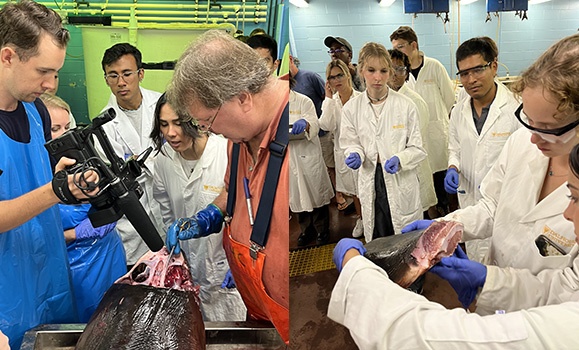Resting on a long metal table and surrounded by more than a dozen students lay a species that has captivated researchers and the public alike for generations, but in many respects remains a scientific mystery.
In a Dalhousie lab, about 40 people gathered to witness a necropsy on a young great white shark that was found on a beach near Parrsboro, N.S., at the end of June. The discovery gave students in the Seaside Summer Shark Course an exceptionally rare opportunity to see up close one of the ocean's most endangered and mythic creatures, while helping in the search for clues as to what led to its death.
"It is so fascinating to be able to see it and be in this room with all of these amazing experts doing their thing," says Emma Martin, a fourth-year marine biology student who was drawn to Dal from Ontario because of the Biology and Conservation of Sharks, Skates and Rays class.
"I've never seen a great white in person before and it's so cool to see what the anthropogenic causes of death are and what we can do about it. This is one of the main reasons I came to Dal."
The shark — a 2.76-metre male estimated to be about seven years old — was retrieved by the (MARS), a charitable conservation group that works to protect marine species through education, research and responding to reports of dead or distressed marine animals.
Tonya Wimmer, the group's executive director and a graduate of Dalhousie's Marine Biology program, received a call on June 24 about the shark and, with the support of scientists from the University of Windsor, were able to collect the endangered species under their Species at Risk Act permit. MARS then arranged to do the necropsy for the Dal shark class with the support of Chris Harvey-Clark, Dal's veterinarian and one of the course's instructors.
A look inside bares a surprise
For more than two hours, the team carefully dismembered the animal and checked it for any indications of the cause of death, while also giving students a highly detailed view of the shark's anatomy. They were able to hold the heart, help dissect certain organs, get an inside view of the liver, check the pancreas, spleen and thyroid, and see the thumb-sized recession that holds the brain.
The shark's stomach — distended and full— also disgorged a small harbour porpoise that was bitten into large, identifiable and mostly intact pieces.
"To have hands-on experience with a very endangered animal is really awesome — it's such a large specimen, so we get to see so much," said Adam Bouma, who is entering his fourth year in in marine biology and came to Dal from Belleville, Ont., largely for the shark course.
"This will give me a better understanding and will help with job interviews because I now have experience with this. I have seen a great white shark cut open — not many people in undergraduate studies would get to do this. It's a once-in-a-lifetime opportunity!"
A valuable resource for researchers
It will also be an important resource for researchers from various organizations who were given dozens of tissue samples to study for insights into shark health and other issues since they don't often have the chance to examine great whites post-mortem.
In an unusual occurrence, two white sharks were also reported to MARS when they washed up in the region last fall and were necropsied, but the causes of death have not yet been determined. Before that, it would be more typical for researchers to hear of a dead white shark every five years or so.
Manuel Dureuil, one of the course instructors, has studied various sharks for years including in areas off South and West Africa, but this was the first time he witnessed a great white necropsy.Â
"We are doing something that even not too many shark researchers would be able to participate in, so I'm just glad the students get a chance to see this up close," he said, watching as Dr. Harvey-Clark guided the class through the dissection organ by organ.
"This is the entire motivation of why we are doing this -- to give 18 super interested young, up-and-coming marine biologists this once-in-a-lifetime experience. It also connects real hands-on science to the sharks."
Wimmer, who did her Master of Biology at Dal, says the opportunity to witness such a necropsy could be the spark that leads some students to pursue certain marine studies.
"For many people, there can be this one moment in their academic career where they go, 'Oh that — that's what I'm really interested in,'" she says.
"It doesn't surprise me at all that there are so many students who come to Dalhousie because of the opportunity to do something like this, especially for a university that has such an ocean lean to it to also have these field courses is huge. It really does enhance the learning experience when you get to do these hands-on things."
Cause of death: unclear
In the end, Dr. Harvey-Clark said there was no clear cause of death and that the shark appeared to be quite healthy with only a couple of abrasions that were likely the result of predation after it died. Diagnostic samples collected by MARS will be provided to veterinary pathologists with the Canadian Wildlife Health Cooperative at the Atlantic Veterinary College for further examination and testing.Â
"It was fun to see the enthusiasm in these smart young people," he said. "This type of learning experience is what helps Dal stand above other institutions in the ocean sciences."

